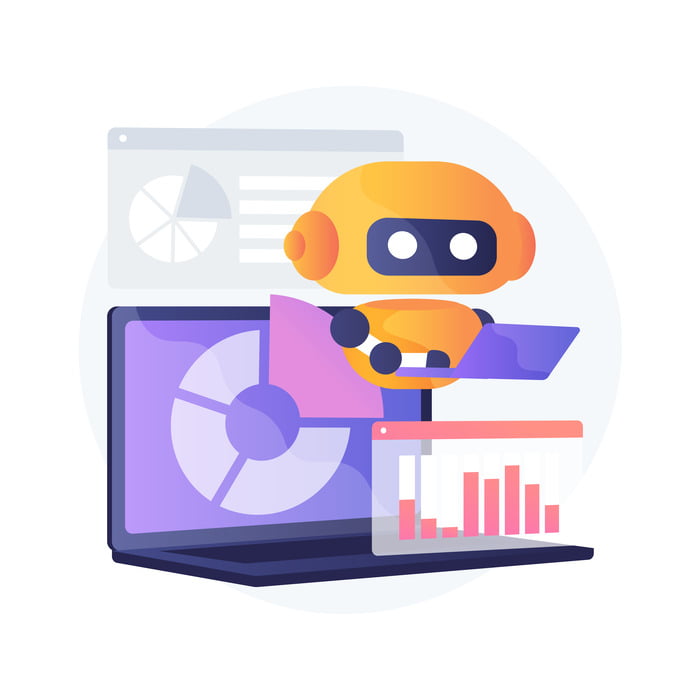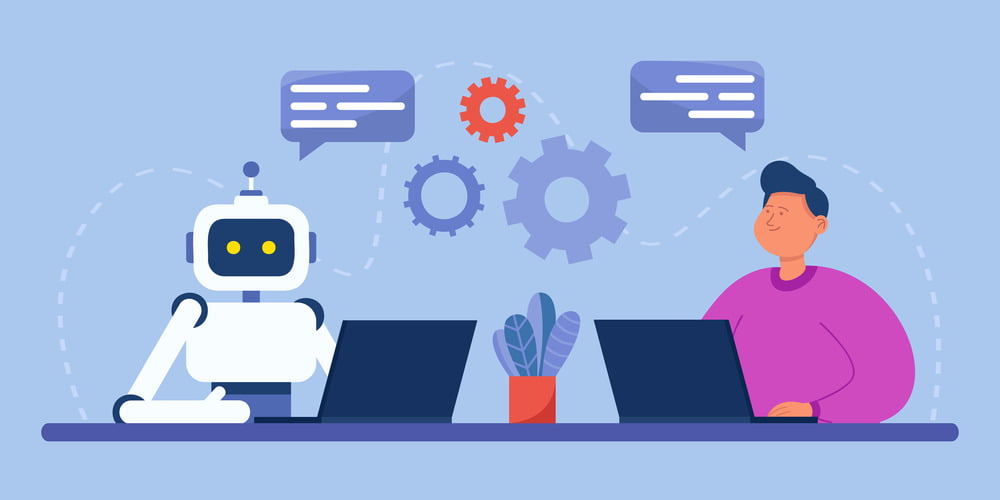In Information Technology Service Management (ITSM), the service desk plays a pivotal role in ensuring smooth operations and providing crucial support. Historically, these desks were predominantly governed by human agents. However, recent technological advancements have led to a growing shift toward the implementation of conversational AI service desks. These AI-powered desks bring enhanced efficiency, quick response times, and a level of consistency unmatched by human-only operations.
By leveraging artificial intelligence, they’re redefining the approach to managing IT challenges and addressing user concerns. This blog aims to give readers a comprehensive understanding of the structure and operation of the conversational AI service desk while also highlighting its distinct advantages in modern IT environments.
Related blog: Chatbots vs. Conversational AI: What’s the Difference?
Importance of conversational AI service desks
IT environments serve as the backbone of most businesses, public services, and even our daily lives. With this shift, there’s been a tremendous surge in the number and diversity of devices, applications, and systems operating at any given time. As the interconnectedness and complexity of these systems increase, so does the likelihood of challenges, glitches, and unexpected snags. This reality underscores the vital need for a sophisticated, responsive, and efficient service desk. This is where conversational AI service desks come into play.
A conversational service within IT Service Management (ITSM) refers to advanced AI-driven platforms that possess the capability to mirror the intelligence, empathy, and understanding of a human support agent. However, the advantages of these systems extend beyond their ability to mimic human thought and speech. They also represent a transformative leap in the overall functionality of service desks.
An AI service desk isn’t just about efficiently handling a large volume of requests. It’s about diving deeper into problems, employing advanced analytics, and providing rich, context-aware solutions. It is this depth of analytical and problem-solving prowess that differentiates a conversational AI service desk from traditional models.
How do conversational AI service desks work?
Essentially, conversational AI service desks operate on the backbone of Deep Learning algorithms, particularly Recurrent Neural Networks (RNN) and Transformer architectures, facilitating intricate understanding and generation of human language sequences. When a user initiates a dialogue, the system preprocesses the input, tokenizing the language strings and converting them into numerical vectors via embedding.
These vectors, encapsulating semantic information, are then processed by the neural networks, which have been trained on vast linguistic datasets. The depth of these networks, characterized by multiple layers of interconnected nodes, allows for the nuanced deciphering of user intent and sentiment rather than a mere syntactic interpretation.
Complementing this core functionality is the integration of knowledge graphs and databases. When a specific query is registered, the AI system correlates it with the knowledge graph, fetching pertinent, contextual information. This allows the system to respond not only based on language patterns but also based on factual accuracy and relevance.
Moreover, these service desks leverage Reinforcement Learning (RL) paradigms for their adaptive capabilities. In an RL setup, the AI system receives feedback signals, termed ‘rewards’ or ‘penalties,’ based on the effectiveness of its responses. By constantly optimizing toward maximal rewards, the AI fine-tunes its strategies, resulting in a dynamic feedback loop.
This iterative learning process, paired with continual updates to its knowledge base, ensures that Conversational AI Service Desks remain at the cutting edge, offering precise, context-aware, and technically sound support to users.
Practical examples of conversational AI service desks
Natural Language Processing (NLP)
The foundation of any Conversational AI is its ability to understand human language, an attribute bestowed by NLP. This sophisticated technology translates everyday language into data that the system can interpret.
Example: Consider an employee reaching out to the IT helpdesk with the statement, “I’m locked out of my account.” Instead of relying on specific keywords, the AI, through NLP, comprehends the issue’s essence — the user can’t access their account, possibly due to incorrect login attempts.
Contextual Understanding
Beyond mere words, context is king. Conversational AI systems are designed to grasp the context from ongoing conversations, user history, and other interactions, allowing them to provide more tailored solutions.
Example: If a user had previously inquired about updating software and now asks, “Why is it running slow?” the AI might link the slowdown to the recent software update, offering solutions based on this contextual link.
Adaptive Learning
Machine learning algorithms power Conversational AI, enabling it to evolve with every interaction. It learns from user behaviors, feedback, and its own successes or mistakes, continually refining its responses.
Example: A user provides feedback by saying, “Your last solution didn’t help.” The AI will offer an alternative and remember this feedback, adjusting its future recommendations for similar issues.
Integration with Existing Systems
A conversational AI Service Desk isn’t an isolated entity. It’s deeply embedded within the IT ecosystem, connecting with databases, IT infrastructure, and other relevant tools. This integration allows it to pull data, execute commands, or even perform real-time diagnostics.
Example: Upon receiving a query like “What’s the status of server X?”, the AI can directly access the server’s status, providing the user with real-time data without human intervention.
Proactive Issue Handling
Through pattern recognition and historical data analysis, AI can preemptively identify potential challenges, offering solutions even before a user realizes there’s an issue.
Example: If the AI identifies a pattern where a software update often leads to a specific bug, it can proactively reach out to users with a workaround or a patch even before they encounter the problem.
Related article: AI for Customer Support and Why You Need It
Multi-Threaded Conversations
Humans have limitations when it comes to multitasking. An AI-driven service desk does not. It can manage multiple threads of conversations concurrently without any drop in efficiency.
Example: During peak times, when many users simultaneously ask questions ranging from “How do I reset my password?” to “Is there a scheduled maintenance today?” the AI handles all these queries in real-time, offering instant solutions.
Personalized User Interactions
Over time, as the system interacts with a user, it accumulates a history of past issues, preferences, and solutions provided. This data repository enables the AI to tailor its responses based on individual user profiles.
Example: If a user frequently struggles with a specific software feature and reaches out with a related query, the AI might offer a more detailed step-by-step guide, recognizing the user’s repeated challenges with that feature.
Benefits of conversational AI service desk
Ubiquitous Service Provisioning
One of the standout advantages of an AI service desk is its all-time availability. Unlike their human counterparts who require breaks, vacations, and sleep, AI systems remain operational around the clock. This 24/7 accessibility ensures that no matter when an IT hiccup surfaces – be it in the middle of the night, on weekends, or during public holidays – there is always a responsive mechanism in place to address it promptly. Such relentless availability eliminates potential downtimes, ensuring businesses remain uninterrupted and user satisfaction remains high.
Efficiency in Handling Multiple Requests
The operational bandwidth of a human agent is inherently limited. Typically, they can address one or, at most, two queries concurrently. However, an AI-powered service desk transcends such limitations. Its capability to process, evaluate, and respond to a multitude of requests in parallel means that users don’t have to queue up or wait for their turn. This instantaneity in service provision dramatically improves user experience and accelerates problem resolution.
Advanced-Data Analysis

A conversational AI service desk isn’t just a reactive tool; it’s proactive in its operations. AI thrives on data. With its inherent ability to swiftly sift through and analyze vast repositories of information, AI can discern patterns and trends that might elude human analysts. By doing so, it can predict potential challenges before they morph into full-blown issues.
The forward-looking approach allows businesses to adopt preventive measures, ensuring smoother IT operations and reducing the overall number of IT-related challenges.
Long-Term ROI
The economic dynamics of an AI-based service desk are compelling. While there’s an upfront investment involved in setting it up, the long-term financial trajectory is favorable. First, automating routine and repetitive tasks, minimizes the need for a large human workforce, leading to substantial savings in payroll and related overheads. Secondly, its ability to resolve issues rapidly means reduced downtimes and enhanced operational efficiency, which has positive implications for a company’s bottom line.
When one factor in reduced user frustrations, the continuity of business operations, and the potential for scaling without linearly increasing costs, it becomes clear that the return on investment (ROI) on an AI-driven service desk grows over time, making it an economically sound decision for businesses.
Enhanced User Experience
In today’s digital age, user experience is paramount. An AI service desk, with its rapid response times, predictive problem-solving, and multitasking capabilities, significantly enhances the overall user experience. It ensures that users feel heard, valued, and catered to, thus fostering loyalty and trust.
Advantages of modernizing the service desk
Optimal resource utilization:
Traditional service desks, reliant solely on human agents, often face inefficiencies. Repetitive tasks can consume valuable time and can lead to agent fatigue. With AI taking the helm for such tasks, human agents are liberated from routine and mundane queries.
This shift allows them to focus on more nuanced, intricate, or unique challenges that require human ingenuity, discretion, and expertise. It ensures that the workforce’s skills are used judiciously, fostering job satisfaction and reducing burnout. Moreover, this optimal utilization leads to quicker problem resolution, promoting user satisfaction and trust.
Scalability and flexibility
One of the fundamental attributes of AI-driven systems is their scalability. Traditional human-operated desks have a threshold beyond which they become overwhelmed, leading to delays and potential service degradation. AI, on the other hand, possesses the capability to handle vast volumes of queries, even during unexpected surges.
Whether it’s during a product launch, a system update, or any event that triggers an influx of IT requests, AI ensures unwavering efficiency. This adaptability ensures that businesses can scale up or down based on demand without incurring excessive costs or compromising service quality.
Seamless integration and interoperability
The IT world is an intricate web of systems, tools, and platforms. An isolated solution, no matter how advanced, can become a bottleneck if it doesn’t communicate well with other systems. Recognizing this, modern AI service desk solutions are crafted with integration in mind.
They are designed to dovetail with existing IT Service Management (ITSM) tools, databases, and other relevant systems. This integration ensures a coherent and unified IT support ecosystem where data flows seamlessly, promoting efficiency, reducing redundancies, and eliminating potential points of failure.
Proactive security
Security is a paramount concern in today’s digital age. With cyber threats evolving at an unprecedented pace, traditional security measures can sometimes be caught off guard. AI introduces a dynamic, proactive layer to security. AI can identify anomalies, unusual patterns, or potential threats that might evade standard security protocols by continuously analyzing data traffic, user behavior, and system interactions.
By flagging these in real-time, it acts as an early warning system, allowing IT teams to counteract threats or breaches before they escalate. This not only safeguards valuable data and systems but also enhances user confidence in the platform.
Better decision-making through analytics
Beyond immediate IT support, AI-driven service desks offer another valuable resource: analytics. These systems can generate insights about common issues, user behavior, system performance, and more by processing vast amounts of data. These analytics can guide decision-making, helping businesses identify areas of improvement, anticipate future challenges, and strategize optimally.
Memorable user experiences

AI has the potential to learn and adapt based on individual user behaviors and preferences. Over time, this leads to a more personalized and tailored IT support experience for users. Instead of generic solutions, users receive support that is aligned with their past interactions, preferences, and needs.
Related blog: What is AI Helpdesk?
Conclusion
Unquestionably, the ITSM environment is changing as a result of quick technology development. Businesses are achieving a number of goals with the introduction and widespread use of the conversational AI service desk: they are optimizing their IT support procedures, improving user happiness, and assuring readiness for future scalability and expansion. Organizations are strengthening their position by proactively comprehending, adjusting to, and embracing this AI-driven paradigm. It can go a long way to guarantee they stay relevant and become pioneers in establishing world-class IT service standards.



















